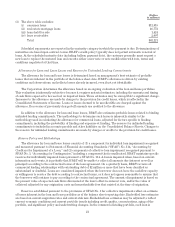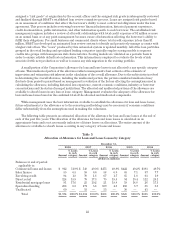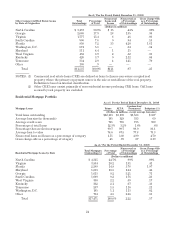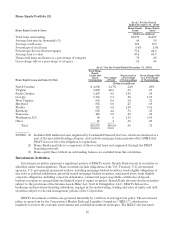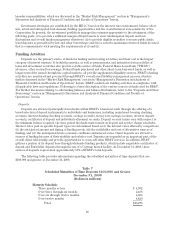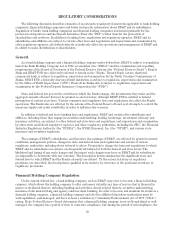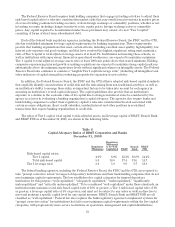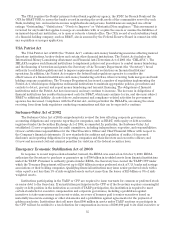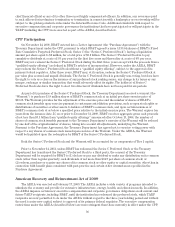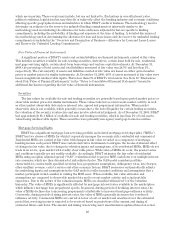BB&T 2008 Annual Report Download - page 31
Download and view the complete annual report
Please find page 31 of the 2008 BB&T annual report below. You can navigate through the pages in the report by either clicking on the pages listed below, or by using the keyword search tool below to find specific information within the annual report.Federal Reserve Board can place any limitations on the financial holding company that it believes to be
appropriate. Furthermore, if the Federal Reserve Board determines that a financial holding company has not
maintained a satisfactory CRA rating, the company will not be able to commence any new financial activities or
acquire a company that engages in such activities, although the company will still be allowed to engage in
activities closely related to banking and make investments in the ordinary course of conducting merchant banking
activities. BB&T became a financial holding company on June 14, 2000, and currently satisfies the requirements to
maintain its status as a financial holding company.
Most of the financial activities that are permissible for financial holding companies also are permissible for a
“financial subsidiary” of one or more of the Banks, except for insurance underwriting, insurance company
portfolio investments, real estate investments and development, and merchant banking, which must be conducted
in a financial holding company. In order for these financial activities to be engaged in by a financial subsidiary of a
bank, federal law requires the parent bank (and its sister-bank affiliates) to be well-capitalized and well-managed;
the aggregate consolidated assets of all of that bank’s financial subsidiaries may not exceed the lesser of 45% of
its consolidated total assets or $50 billion; the bank must have at least a satisfactory CRA rating; and, if that bank
is one of the 100 largest national banks, it must meet certain financial rating or other comparable requirements.
Current federal law also establishes a system of functional regulation under which the Federal Reserve
Board is the umbrella regulator for bank holding companies, but bank holding company affiliates are to be
principally regulated by functional regulators such as the FDIC for state nonmember bank affiliates, the OTS for
thrifts, the SEC for securities affiliates and state insurance regulators for insurance affiliates. Certain specific
activities, including traditional bank trust and fiduciary activities, may be conducted in the bank without the bank
being deemed a “broker” or a “dealer” in securities for purposes of functional regulation. Although the states
generally must regulate bank insurance activities in a nondiscriminatory manner, the states may continue to
adopt and enforce rules that specifically regulate bank insurance activities in certain identifiable areas.
Office of Thrift Supervision Regulation
As a federally chartered thrift, BB&T FSB is subject to regulation, supervision and examination by the OTS.
In connection with the charter conversion of BB&T FSB, Sheffield Financial, LLC and MidAmerica Gift
Certificate Company, which were previously direct operating subsidiaries of BB&T, became divisions or
subsidiaries of BB&T FSB. In addition, Liberty Mortgage Corporation, formerly a subsidiary of Branch Bank,
was reorganized as a subsidiary of BB&T FSB. These organizational structure changes were made to optimize
the operating efficiency of these divisions or subsidiaries and have no impact on BB&T’s reportable segments.
Acquisitions
BB&T complies with numerous laws related to its acquisition activity. Under the BHCA, a bank holding
company may not directly or indirectly acquire ownership or control of more than 5% of the voting shares or
substantially all of the assets of any bank holding company or bank or merge or consolidate with another bank
holding company without the prior approval of the Federal Reserve Board. Current federal law authorizes
interstate acquisitions of banks and bank holding companies without geographic limitation. Furthermore, a bank
headquartered in one state is authorized to merge with a bank headquartered in another state, subject to any
state requirement that the target bank shall have been in existence and operating for a minimum period of time,
not to exceed five years; and subject to certain deposit market-share limitations. After a bank has established
branches in a state through an interstate merger transaction, the bank may establish and acquire additional
branches at any location in the state where a bank headquartered in that state could have established or acquired
branches under applicable federal or state law.
Other Safety and Soundness Regulations
The Federal Reserve Board has enforcement powers over bank holding companies and their nonbanking
subsidiaries. The Federal Reserve Board has authority to prohibit activities that represent unsafe or unsound
practices or constitute violations of law, rule, regulation, administrative order or written agreement with a
federal regulator. These powers may be exercised through the issuance of cease and desist orders, civil money
penalties or other actions.
31


